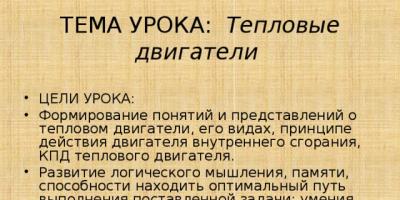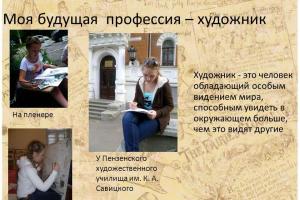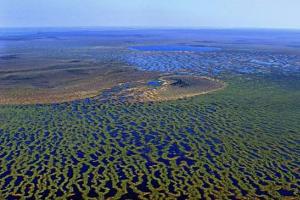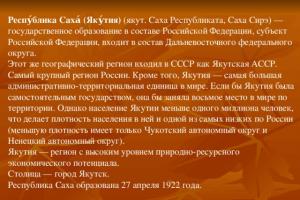TYPE OF LESSON: learning new material.
MATERIALS AND EQUIPMENT:
computer, multimedia projector, screen, multimedia presentation.
METHODS: verbal, visual, problem-search.
FORMS OF WORK: collective, individual, group.
TYPE OF WORK: filling out a cluster, studying a new topic using the strategy “Think for yourself - in pairs - share”, independent work with the textbook.
LESSON PLAN:
I. Organizational moment. Organization of groups. Declaration of the purpose and objectives of the lesson. Checking homework. (Training " Pass on the heat »)
II. Studying new material.
Statement (teacher)
Guys, before we move on to learning new material, let's remember the key terms that will help us decide on the topic of today's lesson. And a crossword puzzle will help us with this, the keyword of which is directly related to the topic of today's lesson. (divided into 3 groups according to the pictures of “Heat engines”. 1- group “internal combustion engine”, 2- group “steam and gas turbines”, 3- group “jet engine”. 3 groups have been formed and your task is to reveal each of the types .
Each group chooses its own group captain and keeps order by filling out the student’s evaluation sheet.
F.I. student
Homework
Problem Level A (5-10)
Answers on questions
New topic
Problem Level A (11,12,1,3,)
Level B (4,5,6)
SLIDE-1. Questions.
1. One of the ways to change the internal energy of the body ( heat transfer).
2. An energy source used in industry, transport, agriculture, and everyday life ( fuel).
3.Kinetic, potential, internal ( energy).
4. You give a tree - it eats, from water - it dies ( fire).
5. The speed of movement of molecules depends on this value ( temperature).
6.Power unit ( Watt).
7. The process of combining fuel molecules with oxygen, which releases energy ( combustion).
8.Unit of energy measurement ( Joule).
9.One type of heat transfer ( radiation).
Mutual check (9-10-“5”, 7-8-“4”, 5-6-“3”)
SLIDE-2. Topic and objectives of the lesson. Studying a new topic (using textbook material).
The topic of today's lesson is “Heat engines”
Today in class we will learn: Fill a cluster.
Human life is impossible without the use of various types of energy, the sources of which are various types of fuel, wind, sun, ebb and flow. There are various types of machines that implement in their work the transformation of one type of energy into another. We will look at one type of machine - a heat engine.
Definition.
SLIDE-3. How does this happen?
"Brain attack" Video showing a model of the operation of a simple heat engine.
Scheme - classification of heat engines.
There are several types of heat engines: steam engine, internal combustion engine, steam and gas turbines, jet engine. In all these engines, the fuel energy is first converted into gas (or steam) energy. The gas, expanding, does work and at the same time cools. Part of its internal energy is converted into mechanical energy.
Work in groups “Think for yourself - share in pairs - tell” to consider the types of heat engines. 1- group “internal combustion engine”, 2- group “steam and gas turbines”, 3- group “jet engine”, performance of each group with its own presentation.
Engine structure and efficiency formula.
Those. A heat engine consists of a heater (a device where fuel is burned), a working fluid and a refrigerator. Gas or steam, which is the working fluid, receives a certain amount of heat from the heater (Q1). The working fluid, heating up, expands and does work (A P) due to its internal energy. Part of the energy (Q2) is transferred to the refrigerator along with waste steam or exhaust gases.
Most of the fuel energy is not used usefully, but is lost in the surrounding space.
TEACHER QUESTION: What is the name of the quantity that shows how much of the energy released by the fuel is converted into useful work by the heat engine? ( Efficiency)
TEACHER QUESTION: Remember how to find the efficiency of a simple mechanism? Student response: ( Find the ratio of useful work to expended)
To find the efficiency of a heat engine, you need to find the ratio of the perfect useful work (A P) of the motor, to the energy received from the heater (Q1).
That is, efficiency shows what part of the energy released by the fuel is converted into useful work. The greater this part of the energy, the more economical the engine.
TEACHER QUESTION: Compare the values of Q1 and Q2. ( Q1>Q2)
TEACHER QUESTION: How much Q1 > Q2? ( to the value of Ap)
TEACHER QUESTION: How can you find a useful job? ( Q1 -Q2)
So A P= Q1 - Q2 and
TEACHER QUESTION: Compare the values of Q1 - Q2 and Q1. ( Q1 -Q2< Q1)
TEACHER QUESTION: What can you say about the meaning of the fraction ( less than 1)
This means that the efficiency is always less than 1, and if expressed as a percentage, then less than 100%.
III. Solving the problem of each group Level A (11,12,13)
Task: What is the efficiency of a heat engine if a quarter of the fuel energy is converted into useful work? (25%)
SLIDE. Physical education minute.
PHYSICAL MINUTE
SLIDE. Statement.
III. Consolidation of the studied material.
Well, now let's once again briefly repeat what we learned in today's lesson.
- What machines are called heat engines?
- What types of heat engines do you know?
- What is the heater of an internal combustion engine?
- What is an internal combustion engine refrigerator?
- How many cycles does an internal combustion engine cycle consist of?
- What measure is shown in Figure 27 of the textbook?
Now I would like to check how well you have learned the new material. To do this, I suggest you sit down at the computers and answer the test questions. But the computer will evaluate your knowledge. And you and I will draw conclusions about what you need to pay attention to when preparing your homework.
Reflection: (finish the sentence)
Today I can rate my work as “___”.
Today I found out...
It was interesting…
I realized that...
Now I can…
I learned…
I managed…
I will try….
I was surprised...
I wanted…
IV. Summing up.
Homework: §21-24 Problem Level B (4-6, 9,10)
View document contents
“Synopsis + presentation of the Physics lesson Thermal engines”
- One of the ways to change the internal energy of the body
( heatper d acha ).
2. Energy source used in industry, transport, agriculture, and everyday life
( topli V O ).
- Kinetic, potential, internal
( energy And I ).
- If you give it to a tree, it eats it; if you give it water, it dies
( O G he ).
5. The speed of movement of molecules depends on this value
( tempera A tour ).
6. Power unit
( Wat T ).
7. The process of combining fuel molecules with oxygen, which releases energy
( mountains e tion ).
8. Energy unit
( Jou l b ).
9. One of the types of heat transfer that we receive from the sun
( And irradiation ).

LESSON TOPIC: Heat engines
- LESSON OBJECTIVES:
- Formation of concepts and ideas about heat engines, its types, the principle of operation of an internal combustion engine, the efficiency of a heat engine.
- Development of logical thinking, memory, ability to find the optimal way to complete a given task; the ability to correctly explain physical concepts and phenomena; improving skills in working with a personal computer.
- Environmental education.

Heat engines are called machines in which the internal energy of the fuel is converted into mechanical energy.

Types of heat engines:
(installed at all thermal power plants, nuclear power plants, water transport, railway transport are now practically replaced).
Steam turbines.
Internal combustion engines.
(road transport, aviation, agricultural and construction equipment).
Jet engines.
(aviation, astronautics).

Timeline of inventions of heat engines
1690 – D. Papen’s steam-atmospheric machine
1705 - T. Newcomen’s steam-atmospheric machine for lifting water from the mine
1763-1766 – steam engine by I.I. Polzunov
1784 – J. Watt steam engine
1865 – internal combustion engine N. Otto
1871 – refrigeration machine K. Linde
1897 – R. Diesel internal combustion engine (with self-ignition)

Steam turbine- a type of steam engine in which a jet of steam, acting on the rotor blades, causes it to rotate.

The history of turbines is the history of the water wheel.
Water wheel with paddles from the 16th century
Water wheel de la - Fe, 1740.
14th century water wheel
Segner wheel 1750
Wheel of Poisel, 1825

Turbines
Laval steam turbine, 1889.
Kaplan turbine, 1900.
Euler turbine, 1754.
Turbine of a modern hydroelectric power station

Creator of the first piston steam engine - 1690


In 1711-1712 English inventor, blacksmith Thomas Newcomen built the first steam (steam-atmospheric) piston-type machine.


Steam engine by I.I.Polzunov
In April 1763, Polzunov demonstrated the operation of a fire-firing machine."
for factory needs"

J. Watt's steam engine
- In 1781, James Watt received a patent for the invention of the second model of his machine.
- In 1782 this remarkable machine, the first universal "double-acting" steam engine, was built.


Internal combustion engine N. Otto
By 1863, the first sample of an atmospheric gas engine with a piston from an aircraft engine and a manual starter running on a mixture of gasoline and air was ready.


Refrigeration machine K. Linde
The award of a prize for the invention of a refrigeration machine for the crystallization of paraffin prompted the professor in 1870 to seriously study the theory of the then non-existent refrigeration industry. Three years later, the first prototype von Linde steam engine, which used methyl ether as a coolant, was tested at the Augsburg brewery. At the same time, the professor received a patent for his invention in the state of Bavaria, and on August 9, 1877, an imperial patent for a machine of the “second design” that ran on ammonia.


R. Diesel internal combustion engine (with self-ignition)
1878 – 1888 Rudolf Diesel is working on creating an engine of a fundamentally new design. It occurred to him to create an absorption engine that would run on ammonia, and the fuel would be a special powder obtained from coal.

Internal combustion engine
The first four-stroke internal combustion engine ran on gas. It was invented in 1878 by the self-taught German physicist Nikolai Otto.

in 1885, a carburetor internal combustion engine was built that ran on gasoline.

- A carburetor internal combustion engine has a carburetor-device into which gasoline and air enter, resulting in a combustible mixture .

4 stroke engine
- 1 stroke - as a result of the downward movement of the piston, the combustible mixture is sucked through the inlet valve, the outlet valve is closed.
- 2 stroke - the piston compresses the combustible mixture, it heats up and is ignited by an electric spark from a candle.

- 3 stroke - hot gases - products of combustion of the combustible mixture - press on the piston and push it down. The movement of the piston is transmitted to the crankshaft using a connecting rod.
- 4 stroke - the piston rises and pushes the exhaust gases through the exhaust valve, which opens at this time

Graph of changes in the state of gas in an internal combustion engine cylinder on p, V- diagram .
- 1.2-Intake
- 2.3-Compression
- 3.4-Working stroke
- 4,5,6,7 release

- Light weight, compactness, and relatively high efficiency (25-30%) have led to the widespread use of carburetor engines. They power cars, motorcycles, motor boats, and are used in chainsaws.
- But there are also disadvantages: they run on expensive high-quality fuel, are quite complex in design, have a high rotation speed of the engine shaft, and their exhaust gases pollute the atmosphere.

Four-stroke diesel engine
Invented by the German engineer Rudolf DIESEL (1858 - 1913) in 1897.


First measure
As the piston moves downward, atmospheric air enters the cylinder through the intake valve.

Second measure
As the piston moves upward, the air is adiabatically compressed to a pressure of approximately 1.2*10 6 Pa, which leads to an increase in its temperature at the end of the stroke to 500-700 0 C.


Third measure
The gases formed during combustion press on the piston and produce useful work while the piston moves downward. The pressure of the expanding gas is maintained approximately constant. At the end of combustion of the injected portion of fuel, adiabatic expansion of the gas occurs. At the end of the stroke, the exhaust valve opens and the pressure drops.

Fourth measure
The piston moves upward and pushes combustion products into the atmosphere.

Graph of changes in the state of gas in the cylinder DD on the p, V-diagram.
Isobars 1-2 - 1 bar
Isobars 2-3- 2 measures
AND Zobara 3-4 , isotherm 4-5 , isochore 5-6 - 3 beat
AND Zobara 6-7 - 4 measure

Advantages of a diesel engine:
Greater efficiency (35-40%).
Low fuel consumption
Cheap fuel
Large torque
Disadvantages of a diesel engine:
Lower power compared to gasoline engines
Higher mass

Rocket engine
ROCKET ENGINE, a jet engine that does not use the environment (air, water) for operation. Chemical rocket engines are common (electric, nuclear and other rocket engines are being developed and tested). The simplest rocket engine runs on compressed gas. According to their purpose, they are divided into accelerating, braking, control, etc. They are used on rockets (hence the name), airplanes, etc. The main engine in astronautics.

Damage to the environment
The negative impact of heat engines on the environment is associated with the action of various factors.
- Firstly, when burning fuel, oxygen from the atmosphere is used, as a result of which the oxygen content in the air gradually decreases.
- Secondly, burning fuel is accompanied by the release of carbon dioxide into the atmosphere.
- Thirdly, when coal and oil are burned, the atmosphere is polluted with nitrogen and sulfur compounds, which are harmful to human health.
- And car engines emit two to three tons of lead into the atmosphere every year.
Emissions of harmful substances into the atmosphere are not the only aspect of the impact of energy on nature. According to the laws of thermodynamics, the production of electrical and mechanical energy cannot, in principle, be carried out without releasing significant amounts of heat into the environment. This cannot but lead to a gradual increase in the average temperature on earth. One of the areas related to environmental protection is increasing the efficiency of energy use and the struggle to save it.

- One of the ways to reduce environmental pollution is to use diesel engines in cars instead of carburetor gasoline engines, the fuel of which does not contain lead compounds. The development of cars that use electric motors or engines that use hydrogen as fuel instead of gasoline engines is promising. Uniform movement of cars, eliminating congestion
- Setting the speed limit in the city to 60 km/h
- Removal of freight flows from the city limits
- Timely elimination of engine malfunctions

Heat engine diagram
Heater T 1
Q 1
Working fluid (gas)
A = Q 1 -Q 2
Q 2
Refrigerator T 2

Toxicity of lead compounds P b (C 2 H 5) 4
- Acts on the nervous system
- Causes mental retardation
- Brain diseases
- Deactivates enzymes
Pb(C 2 H 5 ) 4 + 4KI ------ 4 C 2 H 5 K+PbI 4
Pb 4+ + 4I - ------ PbI 4
yellow color
Safe blood levels
0,2- 0,8 × 10 -4 %


Task: Level A No. 11,12,13 Level B No. 4, 5, 6
Homework: §22-24
Task: Level A No. 14 Level B No. 9,10

A heat engine is a device that performs work by using the internal energy of fuel. All heat engines have the common property of periodic operation (cyclicity), as a result of which the working fluid periodically returns to its original state.



A steam engine is an external combustion heat engine that converts the energy of steam into mechanical work of the reciprocating movement of the piston, and then into the rotational movement of the shaft. The first known device powered by steam was described by Heron of Alexandria in the first century.


An internal combustion engine is a heat engine that converts the heat of combustion of fuel into mechanical work. The first practical gas internal combustion engine was designed by the French mechanic Etienne Lenoir () in 1860. The engine power was 8.8 kW (12 hp).


A steam turbine is a heat engine in which the energy of steam is converted into mechanical work. A gas turbine is a continuous heat engine in which the blade apparatus converts the energy of compressed and heated gas into mechanical work on the shaft.


A jet engine is an engine that creates the traction force necessary for movement by converting the internal energy of the fuel into the kinetic energy of the jet stream of the working fluid. The jet engine was invented by Hans von Ohain, a prominent German design engineer, and Frank Whittle.




State educational institution of JSC "Comprehensive school at penal institutions", Blagoveshchensk
Heat engines.

Heat engines are machines in which the internal energy of fuel is converted into mechanical energy.
The first heat engine known to us was an external combustion steam turbine, invented in the 8th (or 10th?) century AD. era in the Roman Empire. This invention was not developed, presumably due to the low level of technology at that time (for example, the bearing had not yet been invented).
Later, a gunpowder gun and a gunpowder rocket appeared in China. It was a relatively simple device. From a mechanical point of view, a powder rocket was not a heat engine, but from a physics point of view, it was a heat engine. Already in the 17th century, scientists tried to invent a heat engine based on a gunpowder weapon.
Gunpowder projectile in ancient China
- Types of heat engines
- External combustion heat engines:
1. Stirling engine is a thermal apparatus in which a gaseous or liquid working fluid moves in a confined space. This device is based on periodic cooling and heating of the working fluid. In this case, energy is extracted, which arises when the volume of the working fluid changes. The Stirling engine can operate from any heat source.
It was first patented by Scottish priest Robert Stirling on September 27, 1816. However, the first elementary “hot air engines” were known at the end of the 17th century, long before Stirling. Stirling's achievement was the addition of a node, which he called "economy".
Robert Stirling -
creator of the famous alternative to the steam engine, named after him.
In 1843, James Stirling used this engine in the factory where he was working as an engineer at the time. In 1938, Philips invested in a Stirling engine with over two hundred horsepower and over 30% efficiency. The Stirling engine has many advantages and was widely used during the era of steam engines.

2.Steam engine
James Watt - Scottish engineer-inventor, creator of the universal steam engine
Scheme of operation of Watt's steam engine
Main plus steam engines - simplicity and excellent traction qualities. In this case, you can do without a gearbox. For this reason, it is convenient to use a steam engine as a traction engine.
Flaws: low efficiency, low speed, constant water and fuel consumption, heavy weight
Steam engine - any external combustion heat engine that converts steam energy into mechanical work.

Steam Engine Truck
Steam fire engine
Tractor with steam engine
(Efficiency) of a heat engine can be defined as the ratio of useful mechanical work to the expended amount of heat contained in the fuel. The rest of the energy is released into the environment in the form of heat. A steam engine releasing steam into the atmosphere will have an efficiency of 1 to 8%; an improved engine can improve efficiency to 25% or even more.

Thermal power plant can achieve an efficiency of 30-42%. Combined-cycle plants can achieve an efficiency of 50-60%.
At thermal power plants, efficiency is increased by using partially exhausted steam for heating and production needs. In this case, up to 90% of the fuel energy is used and only 10% is dissipated uselessly in the atmosphere.


INTERNAL COMBUSTION HEAT ENGINES:
- ICE (internal combustion engine) is an engine during the operation of which part of the burning fuel is converted into mechanical energy.
The first internal combustion engine was invented and created
E. Lenoir in 1860. The working cycle consists of four strokes, for this reason this engine is also called a four-stroke engine. Currently, such an engine is most often found in cars.
Rudolf Diesel (1858-1913).
German engineer, creator of the internal combustion engine,
currently used

2. Rotary internal combustion engine
This type of engine is relatively simple and can be created in any size. Instead of pistons, a rotor is used, rotating in a special chamber. It contains the intake and exhaust ports, as well as the spark plug. With this type of design, the four-stroke cycle is carried out without a gas distribution mechanism. In a rotary internal combustion engine, cheap fuel can be used. It also creates virtually no vibrations and is cheaper and more reliable to manufacture than piston heat engines.
"Mazda" based on a rotary engine.

3. Rocket and jet thermal engines.
The essence of these devices is that thrust is generated not by a propeller, but by the release of engine exhaust gases.
They can create draft in a space without air.
There are solid fuel, hybrid and liquid). And the last subtype is turboprop thermal engines. Energy is created by the propeller and by the release of exhaust gases.
Jet engine design diagram

An-140 - turboprop cargo-passenger aircraft

To use presentation previews, create a Google account and log in to it: https://accounts.google.com
Slide captions:
Heat engines
A heat engine is a machine in which the internal energy of fuel is converted into mechanical energy. Steam engine Internal combustion engine Steam and gas turbines Jet engine Types of heat engines Currently, heat engines are also in use that use the heat released in the reactor, where the splitting and transformation of atomic nuclei occurs.
Refrigerator – T 2 Q 2 Q 1 A ′ = Q 1 -Q 2 Efficiency of a heat engine Efficiency of an ideal heat engine Operating principle of a heat engine Cylinder with a working substance Heater – T 1
1 - cast iron cylinder in which the piston 2 runs. A steam distribution mechanism is located next to the cylinder. It consists of a spool box connected to the steam boiler. In addition to the boiler, the box communicates through hole 3 with the condenser and with the cylinder through two windows 4 and 5. The box contains a spool 6, driven by a special mechanism through draft 7. Piston steam engine
2 1 Examples of heat engines 1 - internal combustion engine, 2 - rocket engine During operation, a heat engine receives an amount of heat Q 1 releases Q 2. Work done A′ = Q, - Q 2.
1 - air intake, 2 - compressor, 3 - combustion chamber, 4 - turbine, 5 - nozzle. 1. Aviation turbojet engine Examples of heat engines
1 - exhaust gas pipe, 2 - nozzle, 3 - piston, 4 - air filter, 5 - air blower, 6 - cylinder, 7 - connecting rod, 8 - crankshaft. 2. Diesel
1 - inlet pipe, 2 - turbine impeller, 3 - turbine guide blades, 4 - outlet steam line. 3. Steam turbine
Diagram of a gasoline internal combustion engine Diagram of equipment of a steam power station Diagram of a Diesel engine
Turbine (piston machine) Condenser Pressure pump Water cycle diagram for a steam power plant Boiler Suction pump Collection
Approximate energy balance of a thermal power plant Approximate energy balance of a steam power station with a turbine Efficiency of a steam power station
“Efficiency” - Weight of the bar. Efficiency Assemble the installation. The existence of friction. The ratio of useful work to complete work. Archimedes. Measure the traction force F. Determination of efficiency when lifting a body. Do the calculations. Rivers and lakes. Path S. Solid. Concept of efficiency.
“Heat engines and environmental protection” - Heat engines and environmental protection. Classification of transport by energy source. Irreversibility of thermal processes. Ecological map of Moscow. How to save your land. Advantages and disadvantages. Thermal power plants operate on fossil fuels. Thermal ES. Streamlining traffic flow. Ecological research data.
“Types of Heat Engines” - Harm. Internal combustion engine. Short story. The importance of heat engines. Types of heat engines. Steam turbine. Brief history of development. Heat engines. Carnot cycle. Reducing environmental pollution. Rocket engine.
“Thermal engines and the environment” - The principle of operation of an injection engine. Papin Denis. These substances enter the atmosphere. Tsiolkovsky Konstantin Eduardovich. Heat engine diagram. Refrigeration unit. Environmental problems of using thermal machines. Environmental protection. Polzunov Ivan Ivanovich. Heat engines. They release substances harmful to humans, animals and plants into the atmosphere.
“Use of thermal engines” - Number of electric vehicles. In agriculture. Application of heat engines. Heat engines. In road transport. Environmental pollution. German engineer Daimler. Russian mechanic Ivan Polzunov. A ton of gasoline. What did you observe? Greening cities. On the railway. Engineer Gero.
“Heat engines and machines” - Internal combustion engine. Stroke cycles of a four-stroke engine. Heron's ball. Solving environmental problems. Diesel. Environmental problems of using thermal machines. Double-casing steam turbine. Variety of types of heat engines. Model of an internal combustion engine. Steam turbine. Stroke cycles of a two-stroke engine.
There are 31 presentations in total








